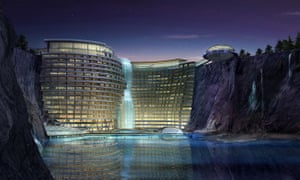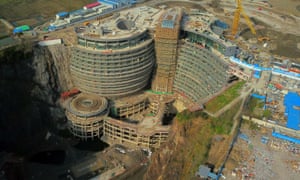Source: The Guardian (3/22/18)
Views are the pits: welcome to China’s quarry hotel
Sixteen of Shanghai hotel’s 18 floors are technically underground, and the bottom two will be underwater
By Benjamin Haas, China correspondent

The Shanghai quarry hotel will feature two storeys that are underwater. Photograph: Atkins/REX/Shutterstock
A hotel built in an abandoned quarry that plunges 80 metres below ground level is nearing completion in China, part of a wave of ambitious architectural projects spurred by rapid economic growth.
The majority of the hotel on the outskirts of Shanghai hugs the wall of a deep pit, and 16 of the 18 floors are technically below ground, with two floors slated to sit underwater in a lake at the bottom of the quarry. There will be 336 rooms and an underwater restaurant when the Sheshan Shimao quarry hotel opens in late May.
The project’s chief engineer described it as a “fight against gravity” in an interview with the state-run China Daily last year. It was designed by the British firm Atkins but has been engineered by Chinese companies.

The Shanghai hotel takes shape. Photograph: Imaginechina/REX/Shutterstock
The hotel is set to cost 1bn yuan (£111m) and it initially broke ground in 2012, but construction did not start until late 2013 and the project has been beset by several delays.
Guests may be able to indulge in rock climbing on the same surface the hotel is built into, according to local media reports.
In recent years China has become renowned for bizarre and sometimes terrifying architecture.
A glass bridge strung between two mountains in central Hunan province rose 300 metres off the ground, and had to be closed for maintenance less than two weeks after it opened.
As the country’s wealth rose, so did a series of peculiar buildings. Some were more literal, designed to look like liquor bottles or teapots, while others were more whimsical, like the headquarters of China’s state broadcaster CCTV in Beijing. There has also been a proliferation of replicas, from the White House to the Eiffel tower.
But the government moved to crack down on such buildings in 2016 when it released a directive that said architecture should not be “oversized, xenocentric, striving for weirdness” or lacking in traditional cultural features. That followed a a call in 2014 by president Xi Jinping to end “weird architecture”.